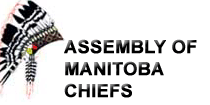The New Vision
The Manitoba Metis Federation, Assembly of Manitoba Chiefs, Manitoba
Keewatinowi Okimakanak and the Province of Manitoba have worked together
to find ways to improve Manitoba's child and family services system.
It was agreed that the new system will recognize cultural differences
and Aboriginal people will provide child and family services to their
people throughout the Province. Manitoba is the first province to
give Aboriginal peoples province-wide responsibility for child and
family services.
What do you think?
This booklet outlines the proposed changes that will make this new
system possible. We want to know what people think about the changes
so a series of public meetings will be held where people can talk
about these changes.
The New System
Under the new system, Aboriginal children and families, no matter
where they live in Manitoba, will receive child and family services
from Aboriginal agencies. These agencies will now be able to provide
services that better reflect the cultural needs of children and families.
Helping to solve problems before they start will be the main focus
throughout the new system. Services will be provided to help keep
children within their families and communities.
Foster parents will still play an important role in the new system.
More Aboriginal families are encouraged to work with the new system
as foster parents.
Background
The child and family services system is very important in Manitoba.
Its job is to protect children at risk of abuse or neglect. It also
helps families, especially those having trouble taking care of their
children.
In 1988, the Aboriginal Justice Inquiry (AJI) started to look at the
relationship between the Aboriginal peoples of Manitoba and the justice
system. Part of the AJI looked at how Aboriginal people were treated
by the child and family services system over the years.
The AJI said good work was being done in serving the child and family
service needs of people living in on-reserve communities. The work
was being done by on-reserve First Nations agencies but these agencies
were not allowed to serve people off-reserve. Aboriginal children
and families living off-reserve received services from the non-Aboriginal
child and family service agencies.
Child Welfare
The AJI report of 1991 said the non-Aboriginal system did not serve
Aboriginal peoples well. It recommended that some changes be made:
- Open the Office of the Child Protector to make sure children's
best interests are always put first.
- Give Aboriginal and non-Aboriginal child and family services agencies
enough resources to provide a full range of services under The
Child and Family Services Act.
- Make sure that the federal and provincial governments give enough
resources to Aboriginal agencies to help them serve Aboriginal
peoples well.
- Change laws to officially establish the new system.
- Set up a mandated province-wide Metis agency.
- Enable existing on-reserve agencies to serve First Nation peoples
living off reserve.
- Set up an Aboriginal child and family services agency in Winnipeg
to serve Aboriginal children and families.
Acting on AJI Recommendations
In 1999, the provincial government introduced the Aboriginal Justice
Implementation Commission (AJIC).
It recommended that the Provincial Government sign an agreement with
the First Nations and Metis political leadership to develop a plan
for Aboriginal agencies to serve Aboriginal peoples.
The AJI-CWI Process
The Province, the First Nations and Metis leaders signed agreements
which led to the creation of the Aboriginal Justice Inquiry - Child
Welfare Initiative (AJI-CWI).
The AJI-CWI set up committees to develop a plan to change the child
and family services system in Manitoba. The committees have members
representing the Provincial Government, the Assembly of Manitoba Chiefs,
the Manitoba Metis Federation and the Manitoba Keewatinowi Okimakanak.
The process has five phases. Phase 1 and 2 are completed. In Phase
3, following public feedback, a more detailed plan will be developed.
During Phases 4 and 5, beginning in January 2002, changes will be
implemented. All phases will be finished by October 2003.
Design Principles
A number of principles were set out to guide what the new system would
look like.
A New Way
The new child and family services system will change the way the Provincial
Government and Aboriginal peoples work together in providing child
and family services. There will be more sharing of duties in this
important service area.
The Minister of Family Services and Housing will give responsibility
for the management of service to First Nations (on- and off-reserve)
and Metis children and families to the four new authorities.
The Authorities will mandate and fund child and family services agencies.
Responsibilities
Under the new system, the Province of Manitoba will be responsible
for setting laws, policies and standards for the new system. The Province
will work together with the system in providing services. The Province
will also approve and provide funding to the Authorities and will
serve as the final level of appeal in certain matters.
Under the new system, the Authorities will design and manage the delivery
of child and family services throughout the province, assist in setting
standards and provide funding to agencies which qualify to deliver
services.
Under the new system, the Agencies will work together with the Authorities
and the Province of Manitoba in delivering child and family services.
Objectives
The main objectives of the new system are to protect children, ensure
their well being, and strengthen families and communities through
culturally appropriate supports and services.
Range of Services
The agencies will be responsible for the design and delivery of services
that support families and communities and protect children.
System Coordination
All four Authorities and their agencies will be serving the needs
of people across the province at the same time. The system must work
together to make sure people receive service in a timely and efficient
way, leaving no child at risk.
Who Do I Call For Service?
People in need of child and family services will call a toll-free
number.
The new system will ensure no child is left at risk.
Who Will Provide Services?
People needing child and family services will be directed to the Authority
with which they most closely identify, based on their culture.
Supporting the New System
Centralized Supports will help the system work smoothly and efficiently.
These include:
- Executive Support Unit staff will make sure the Province of Manitoba's
role is fulfilled in the new system. It will ensure that standards
are followed throughout the new system.
- Computer Systems will be put in place to make sure the Authorities
and the agencies can share information and communicate. The systems
used will ensure confidentiality.
- One of the key parts of the new system is common registries of
information about children in care, prior contact, child abuse,
adoption and post-adoption.
Standing Committee
The Standing Committee, with members from the Authorities and the
Province, will help all parts of the system to work together for the
benefit of Manitoba children and families.
Leadership Council
The Leadership Council will provide a place for political leaders
from First Nations, Metis and the Provincial Government to discuss
issues.
Transition
The change from the old system to the new system will need careful
planning to ensure that it is as smooth as possible.
Legislation
The current system is governed by The Child and Family Services Act
and The Adoption Act. These laws will be changed to reflect the new
system.
Transferring Services
The change from the old system to the new system will be done in stages,
as agencies become ready. Transfers will begin in January 2002 and
be completed by October 2003.
Workforce
The new system will mean changes to the present workforce. At first,
to assist with case transfers, employees from the non-Aboriginal child
and family services system will be loaned to the Aboriginal agencies.
As more Aboriginal people are trained and are ready to be hired, the
loaned employees will be offered reasonable employment in other areas.
Funding the New System
The new system will have a different way of funding which will be
in place by October 2003.
The existing funds and resources will be transferred to the new Authorities.
In turn, the Authorities will give funding and resources to the agencies.
Start up funding will be required.
Residential Care
As the changes are being implemented, the Province, First Nations
and Metis will develop new ways of working together with residential
care providers.









